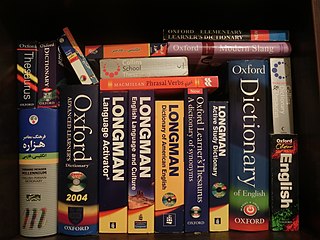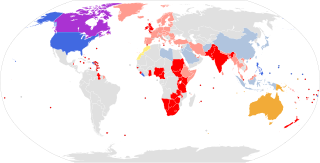See also
| Official languages | |||||||||||||||
|---|---|---|---|---|---|---|---|---|---|---|---|---|---|---|---|
| Indigenous languages |
| ||||||||||||||
| Pidgins, creoles and mixed | |||||||||||||||
| Immigrant languages | |||||||||||||||
| Sign languages | |||||||||||||||
List of Canadian English dictionaries:
Canadian English encompasses the varieties of English native to Canada. According to the 2016 census, English was the first language of 19.4 million Canadians or 58.1% of the total population; the remainder spoke French (20.8%) or other languages (21.1%). In Quebec, 7.5% of the population are anglophone, as most of Quebec's residents are native speakers of Quebec French.

A dictionary is a listing of lexemes from the lexicon of one or more specific languages, often arranged alphabetically, which may include information on definitions, usage, etymologies, pronunciations, translation, etc. It is a lexicographical reference that shows inter-relationships among the data.
Newfoundland English is a term referring to any of several accents and dialects of Atlantic Canadian English found in the province of Newfoundland and Labrador. Most of these differ substantially from the English commonly spoken elsewhere in Canada and North America. Many Newfoundland dialects are influenced by the dialects of England's West Country, in particular the city of Bristol and the counties of Cornwall, Devon, Dorset, Wiltshire, Hampshire and Somerset, while in terms of general cultural heritage, one estimate claims 80 to 85 percent of Newfoundland's English heritage came from England's southwest. Other Newfoundland dialects are influenced by the dialects of Ireland's southeastern counties, particularly Waterford, Wexford, Kilkenny and Cork. Still others blend elements of both and there is also a discernible influence of Scottish English. This reflects the fact that while the Scottish came in smaller numbers than the English and Irish, they had a large influence on Newfoundland society.

Newfoundland and Labrador is the easternmost province of Canada, in the country's Atlantic region. It is composed of the island of Newfoundland and the continental region of Labrador to the northwest, with a combined area of 405,212 square kilometres (156,500 sq mi). In 2021, the province's population was estimated at 521,758. About 94% of the province's population lives on the island of Newfoundland, of whom more than half live on the Avalon Peninsula.

The provinces and territories of Canada are sub-national administrative divisions within the geographical areas of Canada under the jurisdiction of the Canadian Constitution. In the 1867 Canadian Confederation, three provinces of British North America—New Brunswick, Nova Scotia, and the Province of Canada —united to form a federation, becoming a fully independent country over the next century. Over its history, Canada's international borders have changed several times, and the country has grown from the original four provinces to the current ten provinces and three territories. Together, the provinces and territories make up the world's second-largest country by area.
Webster's Dictionary is any of the English language dictionaries edited in the early 19th century by American lexicographer Noah Webster (1758–1843), as well as numerous related or unrelated dictionaries that have adopted the Webster's name in honor. "Webster's" has since become a genericized trademark in the United States for English dictionaries, and is widely used in dictionary titles.

Merriam-Webster, Inc. is an American company that publishes reference books and is especially known for its dictionaries. It is the oldest dictionary publisher in the United States.

Newfie is a colloquial term used by Canadians for someone who is from Newfoundland. Some Newfoundlanders, particularly those from the city of St. John's, consider "Newfie" as a slur used by American and Canadian military forces stationed on the island. The term also has its use in mid-to-late 20th century Newfie jokes that depicted "Newfies" as foolish, in particular when told in Canadian French, leading to the derogatory nature of the term. The word was first recorded in a 1942 dictionary of slang.
"Down East", also "Downeast", is a term for parts of eastern coastal New England and Canada, particularly the U.S. state of Maine and Canada's Maritime Provinces, an area that closely corresponds to the historical French territory of Acadia. The phrase apparently derives from sailing terminology: sailors from western ports sailed downwind toward the east to reach the area.

A couch, also known as a sofa, settee, or chesterfield, is a cushioned item of furniture for seating multiple people. It is commonly found in the form of a bench, with upholstered armrests, and often fitted with springs and tailored cushion and pillows. Although a couch is used primarily for seating, it may be used for sleeping. In homes, couches are normally put in the family room, living room, den or lounge, or wherever couches are best appreciated. They are sometimes also found in non-residential settings such as hotels, lobbies of commercial offices, waiting rooms, and bars. Couches can also vary in size, color, and design.
Sir Richard Whitbourne was an English colonist, mariner and author.
This chart shows the most common applications of the International Phonetic Alphabet (IPA) to represent English language pronunciations.

In geography, a bight is a concave bend or curvature in a coastline, river or other geographical feature, or it may refer to a very open bay formed by such a feature. Such bays are typically broad, open, shallow and only slightly recessed.

Despite the various English dialects spoken from country to country and within different regions of the same country, there are only slight regional variations in English orthography, the two most notable variations being British and American spelling. Many of the differences between American and British English date back to a time before spelling standards were developed. For instance, some spellings seen as "American" today were once commonly used in Britain, and some spellings seen as "British" were once commonly used in the United States.

The London and Bristol Company came about in the early 17th century when English merchants had begun to express an interest in the Newfoundland fishery. Financed by a syndicate of investors John Guy, himself a Bristol merchant, visited Newfoundland in 1608 to locate a favourable site for a colony. Upon his return to England 40 people applied for incorporation as the Tresurer and the Companye of Adventurers and planter of the Cittye of london and Bristoll for the Collonye or plantacon in Newfoundland. The company was known as the London and Bristol Company or simply the Newfoundland Company.

Touton refers to a popular traditional dish from Newfoundland, most usually thought of as a pancake-like bread dough commonly made with risen dough. Although pancakes are rarely made from homemade bread dough in Newfoundland, the memory of regional terms still exists in younger generations, such as the British English term tiffin, meaning "small lunch". The dish has a long list of regionally-distinct names, and can refer to two different types of baked or fried dough: the dough cake variant, usually fried; and a baked bun variant, made with pork fat. Toutons are usually served at breakfast or brunch and are on the breakfast menus of many local restaurants.

Newfoundland is a large island off the east coast of the North American mainland and the most populous part of the Canadian province of Newfoundland and Labrador. It has 29 percent of the province's land area. The island is separated from the Labrador Peninsula by the Strait of Belle Isle and from Cape Breton Island by the Cabot Strait. It blocks the mouth of the Saint Lawrence River, creating the Gulf of Saint Lawrence, the world's largest estuary. Newfoundland's nearest neighbour is the French overseas collectivity of Saint Pierre and Miquelon.

The siege of St. John's was a failed attempt by French forces led by Daniel d'Auger de Subercase to take the fort at St. John's, Newfoundland during the winter months of 1705, in Queen Anne's War. Leading a mixed force of regulars, militia, and Indians, Subercase burned much of the town and laid an ineffectual siege against the fort for five weeks between late January and early March 1705. Subercase lifted the siege after running out of provisions and gunpowder.
Swanskin is a close woven twill-weave flannel cloth for work clothes. It was used by fishermen and laborers. It is employed also as Ironing cloth to support on ironing tables.